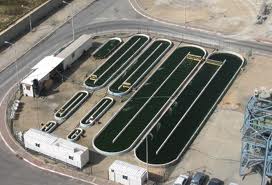Nowhere in the world of algae cultivation is the disagreement as intense as it is when it comes to algae yields in open ponds. Among the various aspects associated with algae mass production, no other aspect is subject to such speculation, disagreement, and exaggeration.

The short answer is, realistically between 2,000 - 4,000 gallons per acre, per year. BUT...
Now for the long answer. 🙂
A quick look at the various literature suggests that the information on growth rates of algae vary over a considerable range, depending on many factors, such as
- Species used,
- Climatic changes and effects,
- Production method used,
- Harvesting method used,
- Measurement system used,
- Production model used.

Most of the reports, on matters of algae yields in open ponds are contradictory and confusing, depending on the effects, or objectives, desired by the investigator. Various people, and still more researchers, have published scores of results, obtained with complicated mathematical formulas and even more on “theoretical maximum results under optimum conditions.”
There are publications which predict unbelievable “maximum yields” or 135 to 346 grams organic weight, per square meter, per day. (m-2 d-1.)The above article posits " 38,000 gallons per acres, per year of unrefined oil."
Which isn't to say they're wrong...in theory.
However people not obtaining even 1/20th. of these results shouldn’t be disappointed because they are very much within the “real world” yields common in mass production of outdoor open ponds.
In addition, it does a great disservice, is misleading, and even not correct, to extrapolate results for mass scale algae production based on input gleamed from limited studies in a laboratory, or even pilot scale.
One also needs to take into account results from a short period of time under the best of conditions and average results determined over a long period of time. Though algae are one of the most prolific of crops, compared with other terrestrial crops in terms of growth, the yield predictions should be made with caution to avoid future disappointments as well as lost dollars by neglecting this aspect in the planning stages.

The yield of algae biomass is expressed normally either as grams (dry matter) produced per square meter per day, or more impressively as tons per hectare per year. Sometimes as well “grams per liter” (g 1-1) is also found.
The problem is, this doesn’t really accurately describe, or reflect, the actual situation in algae cultivation. Where it is not the volume (depth) that has significance, but the light surface area that is the most important aspect to be considered.
To make matters more confusing, most of the available data on yields represent the amount of culture itself being measured, not the actual yield of algae powder which is used to measure the actual finished product. It should also be noted that computed growth rates rarely equal harvested amounts. (But that's another story...)
These difference are normally caused by losses during the harvesting process, times of inactivity, maintenance, infections, contaminations, and other regularly occurring operations. So it wouldn’t be unreasonable to assume a 10% loss in product yield by virtue of normal operations.
Real world algae yields in open ponds
Several figures on growth rates of various algae species are available. For most blue-green alga are in the range of 10-35 g m -2 d -1. are most frequently obtained. Some would argue then, that the technology is such now that optimum levels of production have been reached. That the upper extreme of 30-40 g m -2 d-1 is a charactaristic of photosynthetic algae and can’t be improved further. (Goldman, 1979) I have personally seen 120 grams, per meter, per day.

Spirulina however has a longer doubling time, and statically lower yields in the 8-15 g m -2 d -1 are considered normal. The figures above represent the realistic expectations that must be considered in feasibility of any algae production project.
Any serious study of algae yields needs to also take into account that several decades of algae studies, representing a wide variety of culture systems, algae species, different geographic locations, as well as climates, ponds sizes. etc, we have seen algae productivity steadily rising, both in short term maximums as well as long term averages.
The two most important factor in determining yields is
- sunlight per unit of surface area,
- and time.
By comparing growth rates from laboratory experiments and under field conditions, it becomes clear that the yields in outdoor production are realistically lower. This is usually attributed to varying light conditions.
In contrast, most laboratory under low light and/or artificially lighted, conditions.
At present it is questionable whether the outputs of algae mass cultures can be improved to any significant degree because so many uncontrollable and unpredictable factors are involved.
Also, in respect to yield, it should be noted that the time of day can also influence yield factors. In one strain, scenedesmus, it was found that protein content was highest in the morning, and lowest in the evening. The percentage samples showed a difference between 10-15% of total biomass measured. As such, if the algae being produced in being produced for it’s protein, then it is advisable to harvest during the morning hours.

The objective in outdoor algae cultivation is to maximize yields by manipulating a largely uncontrollable factor...light.
The dependance of algae cultivation on temperature is less well understood. It is known that productivity under 15 C becomes fairly low. Many strains, however can withstand freezing.
On the other side of the spectrum, overheating may be much more important. Die-offs however are common when algae is overheated. The maximum tolerable temperature for most algae is 35 C.
So have we reached the “maximum level of production?”
History is littered with examples telling is “we have reached the maximum level” of many things, only to be disproved with the next accomplishment.
My guess is we haven’t. With the introduction of GMO strains of algae and the current levels of research and dollars being spent there, it makes one wonder if we have even scratched the surface. “Never say never” is an expression that has served me well in this regard.
You can get all the details about building and maintaining open ponds on the only book ever written on the subject. "Building Open Ponds" available by clicking on the graphic below.
You might also be interested in...

Keeping Ponds Free of Invasive Species
Right when you think it couldn't get any better, a two-celled organism decides to take up residence in your pond. Read More
Algae Yields in Open Ponds
Nowhere in the world of algae cultivation is the disagreement as intense as it is when it comes to algae yields in open ponds. Read More

Open Pond Biofuels
Algae Cultivation in Open Ponds: is still the only way to mass produce algae products, however it's not without it's challenges. Read More
The Algae Revolution Has Begun
David Sieg provides more than enough information to tackle this process with confidence...
I’m not a biodiesel expert, but I would say that in his book, Making Algae Biodiesel at Home, David Sieg provides more than enough information to tackle this process with confidence if you have the inclination to tackle a do-it-yourself project of this magnitude, which will require dedication, patience, and natural skill. He provides concise overviews as well as in-depth resources for understanding the process and its variables, including tips from commercial versions and national labs. The guide covers all aspects required, including selecting, growing, harvesting the algae; and making the biodiesel. Though the process is certainly not easy, David skillfully makes it easy enough that it is within the grasp of doing this at home. His guide is well-organized and well-written, accompanied by abundant illustrations, photos, and diagrams.
New Energy Congress



